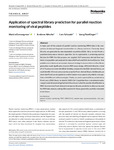Application of spectral library prediction for parallel reaction monitoring of viral peptides
Grossegesse, Marica
Nitsche, Andreas
Schaade, Lars
Döllinger, Jörg
A major part of the analysis of parallel reaction monitoring (PRM) data is the comparison of observed fragment ion intensities to a library spectrum. Classically, these libraries are generated by data-dependent acquisition (DDA). Here, we test Prosit, a published deep neural network algorithm, for its applicability in predicting spectral libraries for PRM. For this purpose, we targeted 1529 precursors derived from synthetic viral peptides and analyzed the data with Prosit and DDA-derived libraries. Viral peptides were chosen as an example, because virology is an area where in silico library generation could significantly improve PRM assay design. With both libraries a total of 1174 precursors were identified. Notably, compared to the DDA-derived library, we could identify 101 more precursors by using the Prosit-derived library. Additionally, we show that Prosit can be applied to predict tandem mass spectra of synthetic viral peptides with different collision energies. Finally, we used a spectral library predicted by Prosit and a DDA library to identify SARS-CoV-2 peptides from a simulated oropharyngeal swab demonstrating that both libraries are suited for peptide identification by PRM. Summarized, Prosit-derived viral spectral libraries predicted in silico can be used for PRM data analysis, making DDA analysis for library generation partially redundant in the future.
Files in this item

